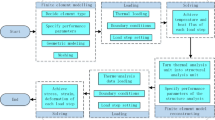Abstract
The formation of a striation pattern in a thin stainless steel tube was investigated by numerical simulation during a pulsed Nd:YAG laser cutting process. The simulated results were compared with the experimental results, which were performed under the same conditions for simulation. The simulated results showed good agreement with the experimental results. Although the formation of the striation pattern was influenced by various laser parameters, the laser power density had become the most important factor in the formation of striation patterns, since the laser power density is the most influential in the heating of metal, and the striation formation is caused by the ejection of molten metal and evaporation during laser cutting process. Although a high power density resulted in clear regular striation patterns, relatively low power density caused the formation of a hot spot, which hindered the formation of regular striation patterns and caused less striation. The numerical simulation calculations can be used to predict the shape of striation patterns and to offer a way to provide a smooth cut wall.
Similar content being viewed by others
References
J.D. Chung, J.S. Lee, K.H. Whang, and T.H. Kim: J. Mater. Processing Manufacturing Sci., 1996, vol. 5 (1), pp. 3–15.
K.A. Bunting and G. Cornfield: J. Heat Transfer, 1975, vol. 97, pp. 116–22.
W.W. Duley: CO 2 Laser, Academic Press, New York, NY, 1976, pp. 248–63.
Y. Arata, H. Maruo, I. Miyamoto, and S. Takeuchi: Trans. JWRI, 1979, vol. 8 (2), pp. 15–26.
A. Ivarson, J. Powell, J. Kamalu, and C. Magnusson: J. Mater. Processing Technol., 1994, vol. 40, pp. 359–74.
John Powell: CO 2 Laser Cutting, Springer-Verlag, New York, NY, 1998, pp. 214–15.
J. Mazumder and W.M. Steen: J. Appl. Phys., 1980, vol. 51 (2), pp. 941–47.
T.H. Kim, K.C. Chong, B.Y. Yoo, J.S. Lee, and K.H. Whang: J. Mater. Sci., 1995, vol. 30 (3), pp. 784–92.
C.P. Hong and W.H. Baek: J. Kor. Inst. Met., 1998, vol. 26 (8) pp. 810–21.
Y. Bayazitoglu and M.N. Ozisik: Elements of Heat Transfer. McGraw-Hill, New York, NY, 1988, pp. 209–14.
Author information
Authors and Affiliations
Rights and permissions
About this article
Cite this article
Kim, BC., Kim, TH., Jang, Y. et al. Investigation of striation formation in thin stainless steel tube during pulsed Nd:YAG laser cutting process by numerical simulation. Metall Mater Trans A 32, 2623–2632 (2001). https://doi.org/10.1007/s11661-001-0052-7
Received:
Issue Date:
DOI: https://doi.org/10.1007/s11661-001-0052-7




